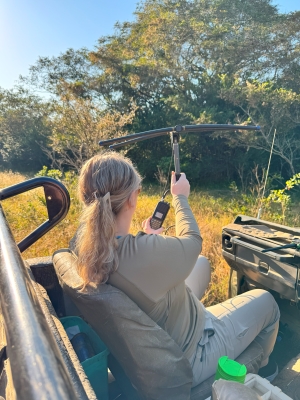Upon landing at the airport in Johannesburg after approximately 22 hours on a plane, the African Conservation Experience crew was waiting. We were briefed on information about South African culture and its effects on poaching. Here, it is much more common for people to seek out sangomas (“witch doctors”) and traditional medicine rather than seek out Western medicine due to the widespread belief in magic. For example, rhinoceros and Pangolin are targeted, as the rhino horn and pangolin scales are believed to have healing properties. Unfortunately, as people poach these animals for healing, it diminishes the species in the wild.
After being debriefed on relevant information and culture, we were transferred for approximately five hours to a remote part of a wild game reserve with over 70,000 acres of land and nine different habitat types. We are staying in a house directly on the reserve and often see wildlife in the yard outside. Upon arrival, our monitor (whose job is to “monitor” the wildlife) debriefed us on pangolin research, safety hazards, and etiquette while on the reserve.
We have been leaving each morning around 6:30 a.m., which is 11:30 p.m. CST. We have commonly been using telemetry to locate Pangolin burrows, which consists of using an antenna and transmitter that collect signals from specific trackers on the Pangolins. When in proximity, the signal is picked up on the antenna and sent to our transmitter, indicating we are near a burrow. The search is part of an ongoing research project to determine the habits, behaviors, and biological information about the Pangolins, as the species is so highly poached for the scales and meat that they are just being reintroduced into the area. Due to the species being so critically endangered, very little is known about it. The species is so endangered that the number of Pangolin in this reserve and the location of the burrows are highly confidential, so I cannot share that information.
 Tracking Pangolin burrows using telemetry, a process that uses signals from the animal tracker for detection.
Tracking Pangolin burrows using telemetry, a process that uses signals from the animal tracker for detection.
Our team was also called to assist with the humane dehorning of a rhino, which is a common practice in the area to remove the incentive for poaching these animals. A large team, including a wildlife veterinarian and the reserve’s warden, is typically involved for the safety of the team and the animal. Once the whole team was on site, the veterinarian explained the dangers of doing this due to the animal, the equipment, and the drugs involved. The medication the rhinos are darted with is a combination of M99, a sedative, and a vitamin. The vitamin and sedative are added to assist with side effects from the M99, such as hypertension and hyperthermia (elevated blood pressure and temperature). M99 is a derivative of morphine that acts as a paralytic agent, and it is incredibly potent. We were instructed not to touch within a 1.5-foot circumference around the dart to avoid contact, as even one drop in will stop a human’s breathing within 3 minutes. Once debriefed, the veterinarian and two conservation team members used the helicopter to locate the rhino, and the veterinarian shot the tranquilizer dart. After the dart is in, the rhino typically takes around four minutes to stop running. The helicopter then herds the rhino towards the rest of the team in oncoming trucks.
 Wildlife veterinary team involved in humane horn trimming to prevent poaching.
Wildlife veterinary team involved in humane horn trimming to prevent poaching. The rhino is blindfolded, and earplugs are placed to reduce stress. Horn measurements and DNA samples (hair, skin, blood) are stored in the conservatory. We ensure the identity of the rhino is logged with a specific system that I can’t speak to; then, the veterinarian uses a chainsaw to trim the horns. The chainsaw is the best choice as it is powerful and efficient, and the blade does not produce heat to avoid damage to the growth plate beneath. Horns are trimmed to have only 3-4 finger widths to prevent damage to the growth plate. The rhinos must be reversed at the 40-minute mark or less, as anything longer can have long-term effects on the rhino.
I chose this internship to determine if wildlife or exotic medicine interested me. In less than one week, I’ve determined that this is a setting I love, as there is so much to learn from, and you are making a direct impact on preventing the poaching of various animal species. Wildlife medicine and conservation could be a specialty I pursue after vet school. I enjoy discussing anti-poaching methods, wild animal behavior, and habits with the conservation teams; they are very informative and happy to spread awareness. I feel that organismal biology and conversations with Professor Josh Otten regarding his research have helped to prepare me to understand how some of the tracking works. I am learning so much already, and I am confident I will continue to learn new things for the remaining three weeks.